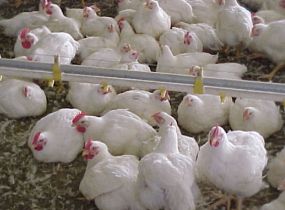Chicken house attics tapped to warm broilers

Reducing the cost of keeping broiler chickens warm could result from research by Agricultural Research Service (ARS) scientists and university cooperators.
Insulating, ventilating and heating broiler chicken houses can be expensive, especially when fuel prices are high, according to study leader Joseph Purswell, an agricultural engineer at the ARS Poultry Research Unit in Mississippi State, Miss. He worked with Barry Lott, a retired professor at Mississippi State University, to investigate ways to reduce the energy costs of heating chicken houses, thus increasing profits for producers.
They found that the air that gathers in broiler house attics can be as much as 20°F (-6.5°C) warmer than the air outside. The attic air is at least 5°F (15°C) warmer about 70% of the time.
Purswell and Lott developed a ventilation system that uses ceiling inlets to redistribute solar-heated attic air, as opposed to bringing in cooler, outside air. They began gathering data in 2006 from a Mississippi chicken producer who installed several broiler houses based on their design.
The scientists concluded that circulating the warmer attic air within the chicken houses reduced the demand for heating fuel by about 20-25%. In one study in mild weather conditions, the technology reduced fuel use by 35%.
Similar technology has been applied to swine and layer facilities, but this is the first research to examine whether the technology works with broiler houses, which have a significantly different construction.
Commercial interest in the technology has increased with rising fuel prices over the past several years, according to Purswell. That has prompted producers throughout the broiler belt to request information on how to take advantage of the technology.
The ventilation system also reduces moisture and ammonia inside the houses, improving air quality.
Source: Agricultural Research Service (ARS), the principal intramural scientific research agency in the U.S. Department of Agriculture.












